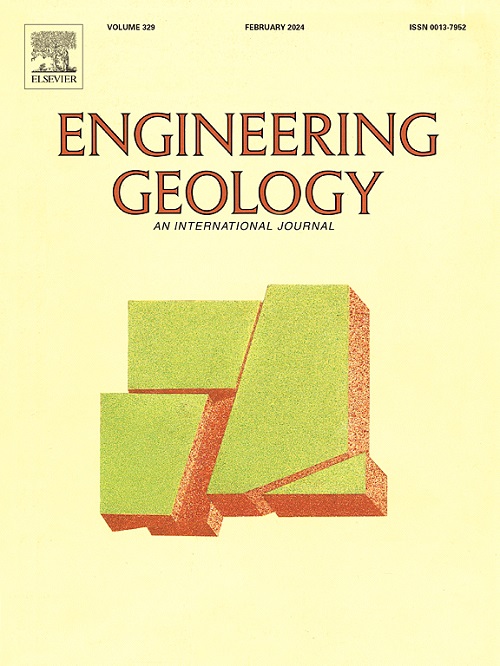Surface weathering of the cliff at Bingling Temple Grottoes: A cultural relic on the Bank of Reservoir in NW China
IF 6.9
1区 工程技术
Q1 ENGINEERING, GEOLOGICAL
引用次数: 0
Abstract
The world cultural heritage Bingling Temple Grottoes (BTG) is a typical sandstone cultural relic on the bank of Liujiaxia Reservoir in the semi-arid region of northwest China. After the construction of the Liujiaxia Reservoir, the changes in the hydrogeological and climatic conditions in the small region have accelerated the weathering process of the cliff bottom. However, the influence of the water reservoir on rock surface weathering remains further understanding. In this study, we quantified the degree of surface weathering of a representative cliff in the BTG. Several typical in-situ tests were carried out, including peeling test, hardness test, and ultrasonic measurement, further supplemented by X-ray diffraction analysis. Despite good correlation among indices for the same lithology, the test results were insufficient for cross-lithology weathering evaluation. Consequently, the modified TOPSIS method was introduced to evaluate weathering across different strata. TOPSIS scores reveal altitude-related variations in weathering degree. Overall, the surface weathering degree of the cliff intensifies from top to bottom. The upper section (> 1743 m) of the cliff is primarily mechanically damaged, in contrast to the bottom layer (influenced by reservoir water level changes), which exhibits severe deterioration and intense chemical weathering related to water. Our study provides experience and methodological reference to the preservation of cultural relics and enhances the understanding of surface weathering of stone heritages on the bank of the reservoir in the semi-arid region of NW China.
炳灵寺石窟悬崖表面风化:中国西北部水库岸边的一处文化遗迹
世界文化遗产炳灵寺石窟(BTG)位于中国西北半干旱地区的刘家峡水库畔,是一处典型的砂岩文化遗迹。刘家峡水库建成后,小区域内水文地质和气候条件的变化加速了崖底的风化过程。然而,水库对岩石表面风化的影响仍有待进一步了解。在这项研究中,我们对 BTG 中具有代表性的悬崖的表面风化程度进行了量化。我们进行了几种典型的原位测试,包括剥离测试、硬度测试和超声波测量,并辅以 X 射线衍射分析。尽管同一岩性的各项指数之间具有良好的相关性,但测试结果不足以进行跨岩性风化评估。因此,引入了改进的 TOPSIS 方法来评估不同地层的风化情况。TOPSIS 分数揭示了风化程度与海拔相关的变化。总体而言,悬崖表面的风化程度自上而下加剧。悬崖上部(1743 米)主要是机械损伤,而底层(受水库水位变化影响)则与水有关,表现出严重的退化和强烈的化学风化。我们的研究为文物保护提供了经验和方法参考,并加深了对中国西北半干旱地区水库岸边石质文物表面风化的理解。
本文章由计算机程序翻译,如有差异,请以英文原文为准。
求助全文
约1分钟内获得全文
求助全文
来源期刊

Engineering Geology
地学-地球科学综合
CiteScore
13.70
自引率
12.20%
发文量
327
审稿时长
5.6 months
期刊介绍:
Engineering Geology, an international interdisciplinary journal, serves as a bridge between earth sciences and engineering, focusing on geological and geotechnical engineering. It welcomes studies with relevance to engineering, environmental concerns, and safety, catering to engineering geologists with backgrounds in geology or civil/mining engineering. Topics include applied geomorphology, structural geology, geophysics, geochemistry, environmental geology, hydrogeology, land use planning, natural hazards, remote sensing, soil and rock mechanics, and applied geotechnical engineering. The journal provides a platform for research at the intersection of geology and engineering disciplines.
 求助内容:
求助内容: 应助结果提醒方式:
应助结果提醒方式:


